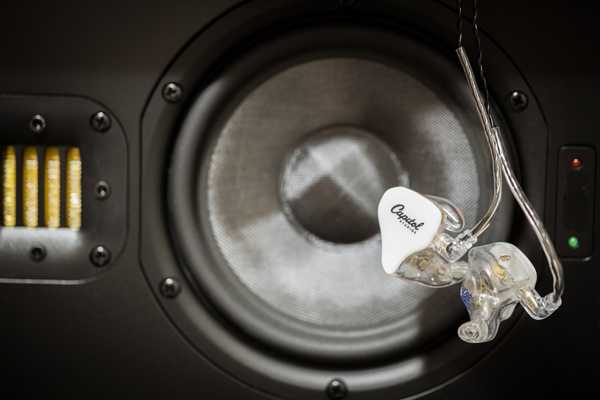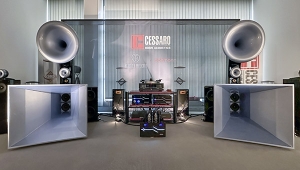| Columns Retired Columns & Blogs |
Ultimate Ears Reference Remastered Custom In-Ear Monitors Page 2

History
In order to make sense of my thoughts on the UERR, it's probably best to start by explaining my experience with its predecessor. Technically speaking, I skipped buying the UERM while it was an active product on the roster. Only when it was discontinued did I find a second-hand model with a price too good to pass up. I sent it out to an extremely well-regarded CIEM maker, who doesn't normally do reshell jobs (he owed me a favor from many years back—and no, I have never reviewed any of his products, and never will due to personal bias). Several weeks and a small FedEx related mishap later, I ended up with a UERM of my own which was theoretically identical to a factory-fresh order. And after extensive listening, I had very mixed feelings about them.
On the one hand, I enjoyed the airy, delicately-layered presentation. Detail retrieval was quite nice, and they had one of the more open, "out of head" presentations I've heard from a (C)IEM. I could totally see why they were so popular.
However, as mentioned by Tyll in ToTL Madness, there were a some aspects of the UERM sound that I wasn't totally sold on. The mid-treble had some extra "zazz" to it, and there was a sort of glassy, sharp feeling around 10kHz which made things overly aggressive. That meant the excellent detail retrieval was a double-edged sword—I couldn't enjoy it for all that long before fatigue set in. Lastly, the low end didn't quite satisfy. Not only did it seem more truncated than I prefer, lacking weight and ultimate extension, but there was also a bit of looseness to the bass which really didn't match the accurate sound I was chasing. Ultimately I felt the UERM sounded like a fairly high-quality, compact, near-field studio monitor—one which would perhaps come in second or third place in a big shootout with multiple options. It was enjoyable for sure—bordering on excellent in some ways—but in the end not something I would end up listening to on a regular basis.
I figured the UERR would be very similar to the UERM, perhaps sporting improved bass extension and a better-behaved treble presentation. If that was the case, I'd be quite pleased with them. After one listen, I knew my theory was wrong—these things are actually quite different.
Listening
The UERR has a generally darker presentation than its predecessor. While the UERM could get rather intense around the 10kHz range, this new model has a smoother, more toned down presentation which still manages to come across as very nicely detailed. Interestingly, the end result still ends up fitting comfortably into the "neutral" category, though opinions obviously vary as to what constitutes truly neutral sound.
The major changes begin in the upper midrange where UERR actually seems a bit more palpable than UERM. The body and weight of a snare drum stands out as being more present, while complex piano runs are better defined and controlled. Vocals, particularly the male variety, also sound slightly richer and more natural. The "zazz" is no longer an issue.
Things flip-flop from there, with the new model being shelved down by a growing amount beyond 2kHz. This makes vocals appear more integrated into the mix rather than floating out in front, with potentially less sibilance depending on the recording. As we climb higher up the spectrum, things like attack and general crispness of instruments feel thoughtfully reduced on the UERR, with the largest delta hitting around that 10kHz mark. As mentioned prior, the UERM could get pretty intense in that range, particularly with cymbals, and to my ears the UERR sounds considerably more natural there.
Looking back at UE's claims for their new True Tone high-frequency driver makes me stop and think a bit. On the one hand they mention "increased extension". While the signature ends up being toned down in the upper mids and highs, the UERR does in fact extend higher than most other IEMs. Using test tones, I can hear significant improvement in the response at 18-19kHz—the UERM drops off quickly in that area. On the other hand, UE mentions the new driver technology as having a "flatter" response, and that's a bit tougher to confirm. The new model does away with the 10kHz spike but does so by shelving down the response, to the point where some people may wish for more presence. Replacing a peak with a valley is not really the way to show how "flat" your driver can sound. How much of this is due to the newer driver, and how much is just deliberate tuning adjustments? Hard to say one way or the other.
The cumulative result is a somewhat darker and slightly warmer overall tone, with less emphasis on speed and air. Bass impact feels more prominent but I'd say that relates to the overall darker tone rather than a specific bass boost. If I level match at 1kHz and compare directly, the bass is pretty much identical in terms of level. I do think the UERR has somewhat improved extension though, as it doesn't seem as truncated in the sub-bass region. It's quite good in this iteration, if still not the tightest, most articulate bass I've ever experienced.
In my mind, the only real casualty is that expansive, almost out-of-head feeling given by the UERM. The Remastered version still has very accurate imaging, but the general size of the presentation does end up feeling smaller. Some people aren't very sensitive to this at all—I know plenty of folks who hear all (C)IEMs as rather "between the ears" anyway, so they likely wouldn't notice this difference. For some listeners though, the perceived head-stage of (C)IEMs is a big draw, and those users may have preferred the original UERM presentation. Which is too bad since, as I mentioned before, that model disappeared as soon as the Reference Remastered launched.
As I scan my above paragraphs, it makes the UERR seem almost like a 1st-gen Audeze LCD-2—rich, thick, and dark. But I can assure you that's not the whole picture. It only seems that way in relation to the UERM, which again was on the thinner/brighter side of neutral. Compared to many other top-caliber custom IEMs—Noble Audio K10, Empire Ears Zeus, or pretty much any model from JH Audio—the UERR is very low on coloration. I would indeed be comfortable using the term "neutral" with the caveat that it isn't the same take on neutral as a Sennheiser HD800 or Stax SR009—which seems to be the style that the UERM was shooting for.
When I try to think of a headphone or IEM that closely matches the UERR, I find myself at a loss. It has definite shades of the lovely sounding Oppo PM-3 (general tonal balance), the classic Westone ES5 (engaging midrange), and even the HiFiMAN HE1000 (relaxed tone without being too dark), but none of these is really a great comparison overall. The discontinued Empire Ears Supra 2 CIEM is vaguely close, as is the (also now obsolete) Cosmic Ears BA4, but those might actually have more in common with the original UERM in their brighter tonality. Perhaps the closest match I can find is the somewhat obscure Jomo Audio 6R, though again, it's not identical by any means. No, Ultimate Ears has truly created something unique here, and for my tastes it just works.
During my listening, I discovered that the UERR prefers—almost demands—a very low output impedance. Using something like the Pono or Cowon Plenue 1, each with a roughly 3 ohm OI, tips the bass presentation over the top. I know some folks actually enjoyed UERM best with a slightly higher output impedance, which gave it a mild but desirable bass boost. But with the shift in tonality, that really doesn't work on the newer model—it ends up sounding overblown and mushy.
I also notice that the UERR is significantly less sensitive than its predecessor. In order to achieve similar levels, I have to be rather liberal with the volume knob. That's not to say it still can't be driven to reasonable levels by most phones and tablets, but if you tend to listen to quieter jazz or classical recordings, and prefer high volumes, you might run into trouble.
Most DAPs are plenty powerful to drive the UERR with authority. That said, I tend to prefer models with fairly potent output stages for whatever reason. The Questyle QP1R, which I typically enjoy, is not a great match in this case—not terrible, but a bit thin and lifeless. The Fiio X5 mark III does a great job, as does the little Cayin N5ii, both sounding more full bodied and fleshed out than the previously mentioned Questyle. My favorite pairing is probably the Astell & Kern KANN which has a sub-1 ohm OI via the single-ended output, plus gobs of well-controlled power. That's a combo I could listen to for many hours on end thanks to KANN's large battery and UERR's non-fatiguing signature.
For home use, the Rupert Neve Designs RNHP is exceptional, as is the Wall of Fame Arcam rHead. Both have excellent grip and control, quiet backgrounds, and zero hiss, while offering the ability to easily fine tune volume levels. The UERR is less sensitive than most of my other CIEMs so it sometimes pairs better than others when amplifier gain is a bit high—but you've still got to be careful with it.
Conclusion
The Ultimate Ears Reference Remastered is something of an mystery to me. In some ways it doesn't make sense. UE had a loyal following with the original model, so why change things up so drastically? Surely a mildly tweaked/improved update would have been a guaranteed success. They took a bigger risk by going in a different direction, and compounded that risk by immediately discontinuing the prior model. With that in mind, I'm forced to speculate that the folks at Capitol Studios must have felt this presentation to be more "correct", regardless of expectations or history. Rather than taking the safer route, they went with the tuning they felt best represented what they hear in their control room.
That may be a difficult pill to swallow for some folks. Long time UERM fans looking for a potential upgrade may not like what they hear. If the stock Sennheiser HD800 strikes you as truly neutral, then the Reference Remastered could very well end up sounding too dark for your tastes. In that case I would steer you towards the Jomo Audio 6R as a more suitable evolution of the original Ultimate Ears Reference Monitor.
Me? I quite enjoy the UERR sound signature. The somewhat darker tonality is a perfect fit for my tastes, while still feeling plenty accurate and—dare I say it—neutral. Detail still abounds but is presented in a more natural way, and to my ears does in fact seem more "right" than the brighter UERM.
I own several dozen CIEMs and the UERR stands alone as a unique tuning, which is an accomplishment in and of itself in this saturated market. Using some of my favorite high-end gear—a ModWright Oppo 205 player, the Resonessence Labs Mirus Pro Signature Edition DAC, and Pass Labs HPA-1 amp—the UERR produces rich, tangible sound that digs deep into the music without a trace of harshness. While it may not be positioned at the apex of the Ultimate Ears lineup, I still consider this a top level CIEM... making it something of a bargain considering the typical flagship pricing these days. Good enough to make it to the Wall of Fame? Absolutely.
Resources
Ultimate Ears Pro home page and UERR product page.
Head-Fi.org thread.
- Log in or register to post comments




































